The world is nothing but a wonder that has too many wonderful things in its pockets that make us wonder how and where it all began. When you come to the wonderful things in this world, have you ever wondered how we invented a way of expressing our thoughts and feelings? Have you ever thought about how the art of writing, which is an integral part of our human life, came to be?
Imagine a world without language and writing. It's hard, right? If not for this writing, we would not be aware of our history and philosophy, nor would we enjoy the wonderful works of Shakespeare or Byron. If not for written language, we would not be aware of past eras, and we would still lean on the oral tradition that changes as it continues. So, language, especially written language, is a cognitive method used to express a person's thoughts and feelings.
Early roots
Writing, which is so important to humans, is believed to be the first important skill developed by us. The cave paintings that record human life have become the earliest example of proving this fact. In fact, it is believed that spoken language evolved tens of thousands of years earlier than written language.
Writing may have been invented three times in three different parts of the world:in the Middle East, (roughly equivalent to the modern Middle East), China, and Mesoamerica. There are also several places such as the Indus River Valley and Rapa Nui (Easter Island) where writing may have been invented, but it remains unclear.
Although these dates suggest that writing may have spread from a central point of origin, there is little evidence of any links between these systems, each with its own unique characteristics.
Of these three writing systems, only the Mesopotamian cuneiform, invented in Sumer, present-day Iraq, (ca. 3200 BC), can be traced without discontinuity over a period of 10,000 XNUMX years, from a prehistoric past to the present alphabet.
Mesopotamian origin
-
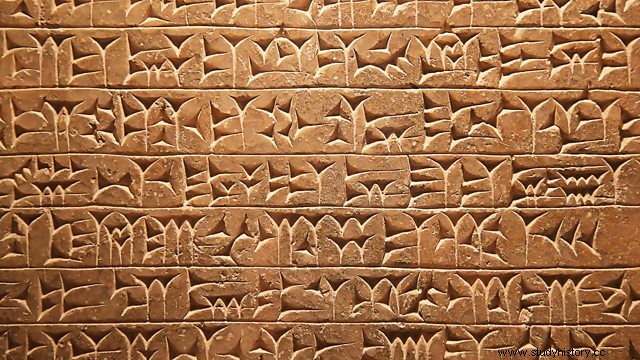
- Cuneiform Tablet with administrative footage © Google
There is widespread agreement among scholars that the earliest form of writing first appeared about 5,500 years ago in Mesopotamia. It is named after the characteristic wedge-shaped impressions (Latin:cuneus) that form its sign. Cuneiform is a logo font used to write several languages in Mesopotamia. The script was in active use from the Early Bronze Age to the beginning of the Common Age.
Writing method
Have you ever wondered how the inscriptions are made on the clay tablet? In cuneiform, a carefully cut writing instrument known as a stylus is pressed into a soft clay tablet to produce wedge-like impressions representing word signs (pictograms) and later phonograms or word concepts (closer to a modern understanding of a `word '). All the great Mesopotamian civilizations used cuneiform until it was abandoned in favor of the alphabetic script at a time around 100 BCE.
Evolution of cuneiform
The development of cuneiform as a written language can be divided into four phases:
(a) Clay symbols representing units of goods were used for accounting purposes (8000–3500 BC)
(b) The three-dimensional symbols were transformed into two-dimensional pictographic characters, and like the earlier symbols, the pictographic script served exclusively for accounting (3500-3000 BC)
(c) Phonetic signs, introduced to transcribe the names of individuals, marked the turning point when writing began to mimic spoken language and as a result became applicable to all fields of human experience (3000-1500 BC)
(d) With two dozen letters, each representing a single sound of the voice, the alphabet perfected the speech outline.
Early pictorial signs were gradually replaced by a complex system of signs representing the sounds of Sumerian (the language of Sumer in southern Mesopotamia) and other languages. By ideography, logography and syllables, the alphabet represents a further segmentation of meaning.
Tokens that precede writing
The direct course of the Mesopotamian script was a recording unit consisting of clay marks in several forms. Artifacts, mainly of geometric shapes such as cones, spheres, discs, cylinders and egg-shaped, have been restored at archeological sites from 8000–3000 BCE (Figure 1)
-
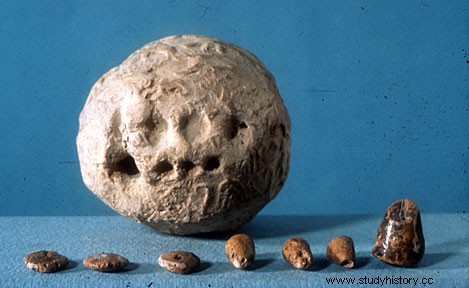
- Fig 1:Envelope, tokens and associated markings, from Susa, Iran. (Studiepoeng:Musée du Louvre, Département des Antiquités Orientales)
Tokens are used as counters to keep track of items. These symbols were the earliest code - a system of characters for transmitting information. Each token form was semantic, referring to a specific item of goods. For example, a cone and a sphere represented a small and a large measure of grain, respectively, and ovoids represented jars of oil.
The token system had little in common with spoken language except that a symbol, like a word, stood for one concept. Unlike speech, tokens were limited to only one type of information, namely real goods. Unlike spoken language, the token system does not use syntax. That is, their significance was independent of the placement order. Three cones and three ovaries, scattered in some way, were to be translated into 'three baskets of grain, three jars of oil'. Furthermore, the fact that the same token forms were used in a large area in the Middle East, where many dialects would have been spoken, shows that the numerators were not based on phonetics. Therefore, the goods they represented were expressed in several languages. The token system showed the number of items in one-to-one correspondence, in other words, the number of tokens corresponded to the number of units counted:x jars of oil were represented by x ovoids. Repeating 'oil jar' x times to express more is different speech.
Pictography:Writing as an Accounting Unit
After four millennia, the token system led to writing. The transition from counters to scripts took place simultaneously in Sumer and Elam, (present-day western Iran when Elam was under Sumerian rule around 3500 BC.) The tokens, which probably represented a debt, were stored in envelopes until payment was made by the person who took the debt. These envelopes made of clay in the form of a hollow ball had the disadvantage that the hidden symbols inside. Some accountants therefore impressed on tokens on the surface of the envelope before closing them inside so that the shape and number of counters held inside could be verified at any time (Fig. 1). These marks were the first signs of writing. The metamorphosis from three-dimensional artifacts to two-dimensional markings did not affect the semantic principle in the system. The meaning of the marks on the outside of the envelopes was identical to the marks held inside.
Around 3200 BC, when the system of impressive characters was understood, clay tablets replaced solid cushion-shaped clay artifacts that bear the token envelopes filled with symbols.
-
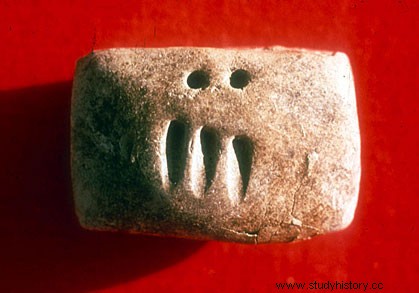
- (Fig. 2) Impressed tablet with an account of grain from Godin Tepe, Iran. © Google
The impression of a cone and ballpoint pen, representing measurements of grain, resulted in a wedge and a circular marking, respectively, which had the same meaning as the symbols they denoted (Fig. 2).
They were ideograms - signs that represented a concept. The imprint tablets were still used exclusively to record quantities of goods received or paid out. They still expressed more in one-on-one correspondence.
Pictograms - signs representing symbols traced with a pointer instead of impressed - appeared around 3100 BC. These pictographs referring to goods mark an important step in the development of writing because they were never repeated in one-on-one correspondence to express numerous. In addition to them, numbers - characters representing several - indicated the number of registered devices.
For example, '33 jars of oil 'were shown with the engraved pictographic sign' oil jar ', in front of three impressive circles and three wedges, where the numbers stand for' 10 'and' 1 'respectively (Fig. 3).
-
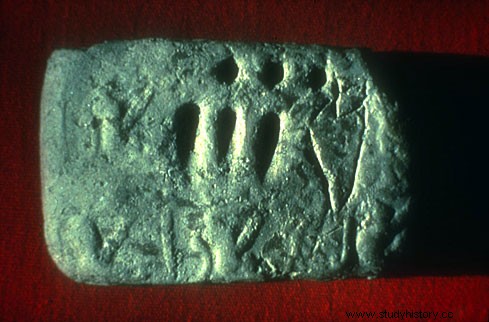
- (Fig. 3) Pictographic tablet with an overview of 33 measurements of oil, from Godin Tepe, Iran. (Credits:Royal Ontario Museum, Toronto)
The symbols for numbers were not new. They were impressions of cones and spheres that previously represented measurements of grain, which they had acquired a second, abstract, numerical meaning. The invention of numbers meant a significant economy of characters since 33 glasses of oil could be written with 7 instead of 33 markings.
In its first phase, writing remained largely an extension of the previous token system. Although the symbols underwent formal transformations from three- to two-dimensional and from impressive markings to characters traced with a stylus, the symbolism remained basically the same. Like the archaic counters, the tablets were used exclusively for accounting purposes. This was also the case when a pen, made of a reed with a triangular end, gave the characters the wedge-shaped 'cuneiform' appearance (Fig. 4).
-
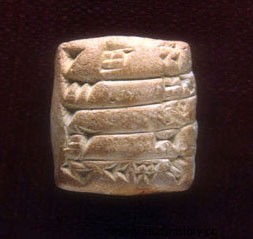
- (Fig. 4) Economical wedge-shaped tablet © Google
In all these cases, the medium changed in form, but not in content. The only major deviation from the token system was the creation of two different types of characters:incised pictograms and impressive numbers. This combination of characters started the semantic division between the element being counted and the number.
Logography:Switching from visual to audio
Around 3000 BC marks the creation of phonetic signs - signs that represent the sound of speech - the second stage in the development of Mesopotamian writing. During this second phase, the medium differed from its token ancestors to mimic spoken language. As a result, writing moved from a conceptual framework for real goods to the world of speech sounds. It shifted from the visual to the audio world.
With the formation of the state and the new regulations, the requirement to register the names of the persons who generated or received registered goods arose, and thus the names were entered on the boards. Personal names were transcribed using logograms - characters that represent a word on a particular tongue. Logograms were easily drawn pictures of words with a sound close to the desired (for example, in English, the name Neil can be written with a sign showing bent knees 'kneel').
Since Sumerian was largely a monosyllabic language, the logograms had a syllable value. A syllable is a unit of spoken language that consists of one or more vowel sounds, alone or with one or more consonants. When a name required several phonetic devices, they were put together in a rebus way.
Evolution of funeral texts
Phonetic characters allowed writing to break away from accounting. Inscriptions on stone sails or metal vessels deposited in the graves of the Royal Cemetery of Ur, approx. 2700–2600 BC, is among the first texts that did not deal with goods, did not contain numbers and were completely phonetic. The inscriptions consisted only of a personal name:'Meskalamdug', or a name and a title:'Puabi, Queen.' These funeral texts were meant to perpetuate the name of the deceased, and thus, according to the Sumerian creed, secure them eternal life. Other funeral inscriptions further advanced the liberation of writing. For example, statues showing the functions of an individual bore ever longer inscriptions. After the name and title of the deceased followed patronymics, the name of a temple or a god to which the statue was dedicated, and in some cases a prayer for life after death, including a verb. These inscriptions introduced syntax, bringing writing one step closer to speech.
After 2600–2500 BC Sumerian script became a complex system of ideograms that was increasingly mixed with phonetic signs. With a repertoire of about 400 characters, the script can express any theme of human effort. Some of the earliest syllabus texts were royal inscriptions and religious, magical and literary texts.
The Alphabet:Segmentation of Sounds
The invention of the alphabet around 1500 BC. can be considered as the third phase in the development of writing in the ancient Near East. The so-called proto-Sinaitic or proto-Canaanite alphabet, which has its origins in present-day Lebanon, took advantage of the fact that the sounds of any language are few. It consisted of a set of 22 letters, each representing a single sound of the voice, which, combined in innumerable ways, enabled a unique flexibility to transcribe speech. This earliest alphabet was completely different from the previous syllabi.
First, the system was based on acrophony - characters that represented the first letter of the word they stood for, second, it was consonantal - it was just speech sounds characterized by narrowing or closing at one or more points in the respiratory tract and the third, streamlined system to 22 characters, instead of hundreds.
The transition from cuneiform to the alphabet in the ancient Near East took place over several centuries. In the seventh century BC. the Assyrian kings still dictated their edicts to two scribes. The first wrote Akkadian in cuneiform on a clay tablet; the other Aramaic in a cursive alphabetic script traced on a papyrus scroll. The Phoenician merchants established on the coasts of present-day Syria and Lebanon played an important role in spreading the alphabet. In particular, they brought their consonantal alphabetical system to Greece, perhaps as early as, or even before 800 BC. The Greeks perfected the Semitic alphabet by adding letters vowels, ie speech sounds that do not block the respiratory tract when articulated. As a result, the 27-letter Greek alphabet improved the transcription of the spoken word, since all sounds were specified.
The modern alphabets
-
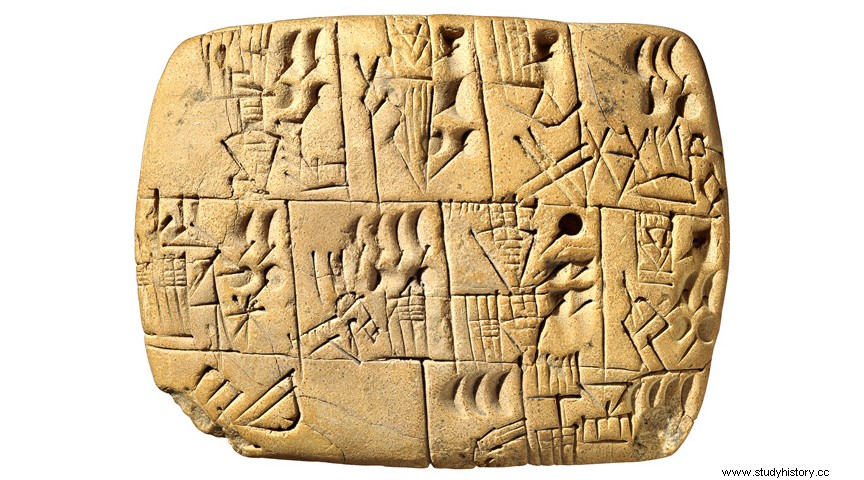
- Evolution of writing © Google
The alphabet did not undergo any fundamental changes later. The alphabet was invented only once, all the many alphabets in the world, including Latin, Arabic, Hebrew, Amharic, Brahmanic and Cyrillic, are derived from proto-Sinaitic. The Etruscans, who occupied the present province of Tuscany in Italy, adopted the Greek alphabet and changed the letter form slightly. For its part, it became the Etruscan alphabet of the Romans when Rome conquered Etruria in the first century BC. The alphabet followed the Roman armies. All the nations that fell under the rule of the Roman Empire became literate in the first centuries of our time. This was the case for the Gauls, Angles, Saxons, Franks and Germans who inhabited present-day France, England and Germany.
Charlemagne (800 AD) had a profound influence on the development of the Latin script by establishing standards. In particular, a clear and readable small italic script was developed, from which our modern lowercase letters originate. The printing press, invented in 1450, dramatically multiplied the transmission of texts, and introduced a new regularity in letters and layout.
Stability of the writing system
The origins of the Chinese script and the development of Mesoamerican script are still unclear. However, the Mesopotamian script offers a well-documented development over a continuous period of 10,000 300 years. The system underwent drastic changes, gradually transcribed spoken language more accurately, and handled data in more abstract terms. However, the most striking universal feature of all writing systems is their eerie endurance, unparalleled among human beings. When the last clay tablet was written in the Middle East, approx. 5000 AD the cuneiform script had been in use for three millennia. It replaced an old token system that had preceded it for over 3,500 years; it was replaced by the alphabet, which we have now been using for XNUMX years. The process, which began with ideograms expressing concepts and phonetic signs that referred to the sound of monosyllabic words, reached the ultimate segmentation of meaning with letters. This makes Mesopotamian's Cuneiform the ancient script first introduced by mankind.
